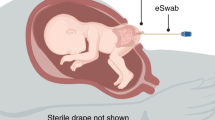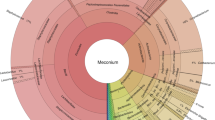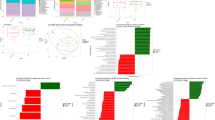Abstract
The modern Western lifestyle may have altered the composition of the commensal microflora. Here, we investigated the first year's intestinal colonization pattern in 99 vaginally delivered Swedish infants and 17 delivered by cesarean section. Rectal swabs obtained at 3 d of age were cultured for aerobic bacteria and fecal samples obtained at 1, 2, 4, and 8 wk and at 6 and 12 mo of age were cultivated quantitatively for aerobic and anaerobic bacteria. Vaginally delivered infants more often had Escherichia coli compared with cesarean section–delivered infants, whereas the latter more frequently carried other enterobacteria, such as Klebsiella and Enterobacter. Independent of delivery mode, it took 2 mo until most infants were colonized by enterobacteria, traditionally the first colonizers. In contrast, coagulase-negative staphylococci colonized 99% of the infants from d 3 onwards. The poor adaptation of staphylococci to the gut was shown by declining population sizes after some weeks. Dominating anaerobes were initially bifidobacteria and clostridia, whereas Bacteroides initially colonized only 30% of vaginally delivered infants and increased very slowly in prevalence. Bacteroides colonization was delayed up to 1 y in cesarean section–delivered compared with vaginally delivered infants. Our results show that some “traditional” fecal bacteria are acquired late today especially in cesarean section–delivered infants, probably due to limited environmental circulation. In their absence, skin bacteria like staphylococci have become the first gut colonizers.
Similar content being viewed by others
Log in or create a free account to read this content
Gain free access to this article, as well as selected content from this journal and more on nature.com
or
Abbreviations
- CFU:
-
colony forming units
References
Mata LJ, Urrutia JJ 1971 Intestinal colonization of breastfed children in a rural area of low socio-economic level. Ann N Y Acad Sci 176: 93–109
Stark PL, Lee A 1982 The microbial ecology of the large bowel of breast-fed and formula-fed infants during the first year of life. J Med Microbiol 15: 189–203
Adlerberth I, Hansson LÅ, Wold AE 1999 The ontogeny of the intestinal flora. In: Sanderson IR, Walker WA (eds) Development of the Gastrointestinal Tract. BC Decker: Hamilton, pp 279–292
Gronlund MM, Lehtonen OP, Eerola E, Kero P 1999 Fecal microflora in healthy infants born by different methods of delivery: permanent changes in intestinal flora after cesarean delivery. J Pediatr Gastroenterol Nutr 28: 19–25
Bennet R, Nord CE 1987 Development of the faecal anaerobic microflora after caesarean section and treatment with antibiotics in newborn infants. Infection 15: 332–336
Fryklund B, Tullus K, Berglund B, Burman LG 1992 Importance of the environment and the faecal flora of infants, nursing staff and parents as sources of gram-negative bacteria colonizing newborns in three neonatal wards. Infection 20: 253–257
Tannock GW, Fuller R, Smith SL, Hall MA 1990 Plasmid profiling of members of the family Enterobacteriaceae, lactobacilli, and bifidobacteria to study the transmission of bacteria from mother to infant. J Clin Microbiol 28: 1225–1228
Adlerberth I, Carlsson B, de Man P, Jalil F, Khan SR, Larsson P, Mellander L, Svanborg C, Wold AE, Hanson LÅ 1991 Intestinal colonization with Enterobacteriaceae in Pakistani and Swedish hospital-delivered infants. Acta Paediatr Scand 80: 602–610
Bennet R, Eriksson M, Tafari N, Nord CE 1991 Intestinal bacteria of newborn Ethiopian infants in relation to antibiotic treatment and colonisation by potentially pathogenic Gram-negative bacteria. Scand J Infect Dis 23: 63–69
Cebra JJ 1999 Influences of microbiota on intestinal immune system development. Am J Clin Nutr 69: 1046S–1051S
Moreau MC, Corthier G 1988 Effect of the gastrointestinal microflora on induction and maintenance of oral tolerance to ovalbumin in C3H/HeJ mice. Infect Immun 56: 2766–2768
Wold AE 1998 The hygiene hypothesis revised: is the rising frequency of allergy due to changes in the intestinal flora?. Allergy 53: 20–25
Nowrouzian F, Hesselmar B, Saalman R, Strannegard IL, Aberg N, Wold AE, Adlerberth I 2003 Escherichia coli in infants' intestinal microflora: colonization rate, strain turnover, and virulence gene carriage. Pediatr Res 2003;54: 8–14
Lindberg E, Nowrouzian F, Adlerberth I, Wold AE 2000 Long-time persistence of superantigen-producing Staphylococcus aureus strains in the intestinal microflora of healthy infants. Pediatr Res 48: 741–747
Ahrné S, Lönnermark E, Wold AE, Åberg N, Hesselmar B, Saalman R, Strannegard IL, Molin G, Alderberth I 2005 Lactobacilli in the intestinal microbiota of Swedish infants. Microbes Infect 7: 1256–1262
Roy D, Sirois S 2000 Molecular differentiation of Bifidobacterium species with amplified ribosomal DNA restriction analysis and alignment of short regions of the ldh gene. FEMS Microbiol Lett 191: 17–24
Bullen CL, Tearle PV, Willis AT 1976 Bifidobacteria in the intestinal tract of infants: an in vivo study. J Med Microbiol 9: 325–333
McAllister TA, Givan J, Black A, Turner MJ, Kerr MM, Hutchison JH 1974 The natural history of bacterial colonization of the newborn in a maternity hospital. I. Scott Med J 19: 119–124
Bennet R, Eriksson M, Nord CE, Zetterstrom R 1986 Fecal bacterial microflora of newborn infants during intensive care management and treatment with five antibiotic regimens. Pediatr Infect Dis 5: 533–539
Lundequist B, Nord CE, Winberg J 1985 The composition of the faecal microflora in breastfed and bottle fed infants from birth to eight weeks. Acta Paediatr Scand 74: 45–51
Borderon JC, Lionnet C, Rondeau C, Suc Al, Laugier J, Gold F 1996 Current aspects of fecal flora of the newborn without antibiotherapy during the first 7 days of life: Enterobacteriaceae, enterococci, staphylococci. Pathol Biol 44: 416–422
Balmer SE, Wharton BA 1989 Diet and faecal flora in the newborn: breast milk and infant formula. Arch Dis Child 64: 1672–1677
Kuhn I, Tullus K, Möllby R 1986 Colonization and persistence of Escherichia coli phenotypes in the intestines of children aged 0 to 18 months. Infection 14: 7–12
Tullus K, Kallenius G, Mollby R 1988 Faecal colonization with P-fimbriated Escherichia coli between 0 and 18 months of age. Epidemiol Infect 100: 185–191
Gothefors L, Carlsson B, Ahlstedt S, Hanson LA, Winberg J 1976 Influence of maternal gut flora and colostral and cord serum antibodies on presence of Escherichia coli in faeces of the newborn infant. Acta Paediatr Scand 65: 225–232
Kearns AM, Freeman R, Lightfoot NF 1995 Nosocomial enterococci: resistance to heat and sodium hypochlorite. J Hosp Infect 30: 193–199
Wilson KH 1993 The microecology of Clostridium difficile. Clin Infect Dis 16( suppl 4): S214–S218
Balmer SE, Scott PH, Wharton BA 1989 Diet and faecal flora in the newborn: lactoferrin. Arch Dis Child 64: 1685–1690
Lennox-King SM, O'Farrell SM, Bettelheim KA, Shooter RA 1976 Colonization of caesarean section babies by Escherichia coli. Infection 4: 134–138
Rotimi VO, Olowe SA, Ahmed I 1985 The development of bacterial flora of premature neonates. J Hyg (Lond) 94: 309–318
Tullus K, Aronsson B, Marcus S, Mollby R 1989 Intestinal colonization with Clostridium difficile in infants up to 18 months of age. Eur J Clin Microbiol Infect Dis 8: 390–393
Swedish Strategic Programme for the Rational Use of Antimicrobial Agents and Surveillance of Resistance. Available at: www.strama.org
Kallman J, Kihlstrom E, Sjoberg L, Schollin J 1997 Increase of staphylococci in neonatal septicaemia: a fourteen-year study. Acta Paediatr 86: 533–538
Hessle C, Andersson B, Wold AE 2000 Gram-positive bacteria are potent inducers of monocytic interleukin-12 (IL-12) while Gram-negative bacteria preferentially stimulate IL-10 production. Infect Immun 68: 3581–3586
Kauffman F 1969 The Bacteriology of Enterobacteriaceae. 2nd Ed. Munkgaard, Copenhagen, pp 362–363
Chapman GH 1949 Comparison of Ludlam's medium with Staphylococcus medium number 110 for the isolation of staphylococci that clot blood. J Bacteriol 58: 823
Isenberg HD, Goldberg D, Sampson J 1970 Laboratory studies with a selective Enterococcus medium. Appl Microbiol 20: 433–436
Livingston SJ, Kominos SD, Yee RB 1978 New medium for selection and presumptive identification of the Bacteroides fragilis group. J Clin Microbiol 7: 448–453
Beerens H 1991 Detection of bifidobacteria by using propionic acid as a selective agent. Appl Environ Microbiol 57: 2418–2419
George WL, Sutter VL, Citron D, Finegold SM 1979 Selective and differential medium for isolation of Clostridium difficile. J Clin Microbiol 9: 214–219
Acknowledgements
The authors thank Birgitta Åberg for excellent help in collection of samples and with interviews, and all the parents and infants for their contribution. We also thank Eva Ågren, Ingela Kinell, and Jolanta Bonislavska for their skillful technical assistance.
Author information
Authors and Affiliations
Corresponding author
Additional information
This study was supported by grants from the European Commission (QLK-2000-00538), the Swedish Foundation for Health Care Sciences and Allergy Research, the Asthma and Allergy Foundation, the Cancer and Allergy Foundation, the Swedish Free Masonry Foundation, and the Swedish Medical Research Council.
Rights and permissions
About this article
Cite this article
Adlerberth, I., Lindberg, E., Åberg, N. et al. Reduced Enterobacterial and Increased Staphylococcal Colonization of the Infantile Bowel: An Effect of Hygienic Lifestyle?. Pediatr Res 59, 96–101 (2006). https://doi.org/10.1203/01.pdr.0000191137.12774.b2
Received:
Accepted:
Issue date:
DOI: https://doi.org/10.1203/01.pdr.0000191137.12774.b2
This article is cited by
-
Microbiome changes: an indicator of Parkinson’s disease?
Translational Neurodegeneration (2019)
-
Impact of delivery mode-associated gut microbiota dynamics on health in the first year of life
Nature Communications (2019)
-
The Human Microbiota and Asthma
Clinical Reviews in Allergy & Immunology (2019)
-
Genetic relatedness of Gram-negative bacteria colonizing gut and skin of neonates and mother’s own milk
Journal of Perinatology (2018)
-
HIV-exposure, early life feeding practices and delivery mode impacts on faecal bacterial profiles in a South African birth cohort
Scientific Reports (2018)



